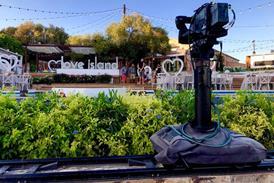BVE 2016: AJA looks likely to focus its camera development efforts on specialist devices rather than slug it out in the congested and highly competitive cine camera sector.
Speaking to Broadcast at BVE earlier this week, AJA president Nick Rashby said he was “not sure” that AJA would develop more cameras with a similar form factor to the Cion, which was the company’s first foray into the camera sector.
“I think we will keep looking at areas where we can make things where there is a need in the market,” said Rashby.
“It would be naïve for us to think we can storm in and take on Sony and Canon and battle it out in that space over and over again.
Rashby on the Cion
“[Cion] is somewhat of an odd beast because it is PL mount at this price point in this particular form factor,” said Rashby.
“The high end guys aren’t necessarily going to use it - they might use an Arri or Red instead – while independent users may want EF lenses.
“But we are finding a sweet spot with professional shooters working on a smaller scale; people doing high end corporate work, or commercial work with smaller crews…those who are skilled enough to know how to light a scene and how to get the best out of a camera are rewarded with beautiful, cinematic images.”
Rashby said that because of the timescales involved in getting a camera to market it was possible for manufacturers to get “caught out”.
“[The Cion] took a huge amount of development for us, and it was worth it, but we have a huge product line and we have to be careful about where we put our resources.
“We are definitely working on other things but we will be a bit more mindful and look for unique ways to leverage the skillset we have.”
RovoCam
AJA launched its second-ever camera earlier this month. The RovoCam, which is a markedly different beast to the Cion, is a compact block camera built on Sony sensor technology with HDBaseT connectivity.
BVE was the first time the RovoCam had been demonstrated to a broadcast audience, and Rashby said he had been pleasantly surprised by the level of interest shown in the device.
“I didn’t think RovoCam would have much play in the broadcast space, but some of the biggest deals we are talking about at the moment are with some of the major sports broadcasters and others that are trying to figure out how to use it, because HDBaseT is a non-standard and slightly weird thing in the broadcast world; people are not quite clear what it is or how you use it, but once you explain [HDBaseT] is uncompressed, UltraHD, video, power – everything over one category cable – and that it is the de facto standard in pro AV, they get interested.”
The RovoCam is essentially the marriage of Sony’s 4K FCB-ER8300 camera system, with back illuminated CMOS sensor technology and Sony image processing with AJA’s HDBaseT interface technology (AJA has a product line of mini converters that convert SDI and HDMI signals to HDBaseT and vice versa).
Support for Sony’s Visca protocol means there is a pre-existing ecosystem and a “whole world” of existing software and hardware control options, Rashby added.
“There really wasn’t anything else like it in the market,” Rashby said. “Because [RovoCam] is based on Sony optics and sensor there wasn’t a huge development effort for us.”





























No comments yet